In Short:
Steins;Gate is a 2011 anime by White Fox that follows the humor and tragedy of self-proclaimed mad scientist Okabe Rintaro as he, and his friends, get in over their heads when they accidentally create a time machine by hooking up a cellphone to a microwave. Steins;Gate features great characters, witty dialogue, one of the better time travel plots around, and easily one of the best English dubs in all of anime.
Steins;Gate has a unique, desaturated art style that may not sit well with anime fans used to more colorful works. It is also one anime where you cannot use the “three episode rule” to determine its quality. Instead, it takes nearly twelve episodes for it to put all its pieces on the board. But, once it is finally ready, it goes all out for a thrilling, non-stop second half.
Suggested Minimum Watch: 3 episodes. You can’t give up on the show until Kurisu is made a lab member. But really, you should watch till episode 12…
Full Review:
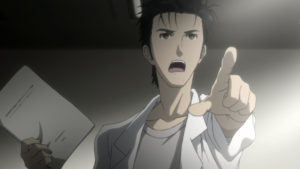 Okabe Rintaro, or “Hououin Kyouma” as he prefers to call himself just because it sounds cooler, likes to pretend he is constantly engaged in a secretive, high stakes battle for the future of humanity against a fictional group he calls “The Organization”. He often speaks in a grandiose, self-important tone, deflects scrutiny away from himself by pretending to get urgent phone calls as if he is a secret agent, and he likes to assign meaningless norse code names to his mundane tasks and projects as if he really is the mad scientist he claims to be.
Okabe Rintaro, or “Hououin Kyouma” as he prefers to call himself just because it sounds cooler, likes to pretend he is constantly engaged in a secretive, high stakes battle for the future of humanity against a fictional group he calls “The Organization”. He often speaks in a grandiose, self-important tone, deflects scrutiny away from himself by pretending to get urgent phone calls as if he is a secret agent, and he likes to assign meaningless norse code names to his mundane tasks and projects as if he really is the mad scientist he claims to be.
In reality, Okabe is an intelligent, if slightly eccentric, university student with a decent sense of humor who lives in a tiny second floor apartment which which he calls the Future Gadget Labratory. He and his best friend, computer hacker and fellow student Itaru “Daru” Hashida, frequently hang out together and come up with silly inventions in their spare time. Although he can in no way be called normal, Okabe mostly keeps up his mad scientist act for the benefit and delight of his childhood friend Mayuri Shiina.
 One day, while attending a lecture on the possibility of time travel, Okabe is pulled out into a hallway by genius university student Makise Kurisu. Strangely, Makise demands to know what Okabe wanted to tell her earlier… which is odd because Okabe has never spoken to her before in his life. Stranger still, just minutes later, Makise later ends up lying dead in a pool of her own blood at that same conference! But, strangest of all, is that everything seems to shift when Okabe texts news of Makise’s murder to Daru. Okabe soon finds out that the events of the past day have drastically changed. In this new timeline, Makise is still very much alive. In fact, she is the one now holding a talk on the impossibility of time travel.
One day, while attending a lecture on the possibility of time travel, Okabe is pulled out into a hallway by genius university student Makise Kurisu. Strangely, Makise demands to know what Okabe wanted to tell her earlier… which is odd because Okabe has never spoken to her before in his life. Stranger still, just minutes later, Makise later ends up lying dead in a pool of her own blood at that same conference! But, strangest of all, is that everything seems to shift when Okabe texts news of Makise’s murder to Daru. Okabe soon finds out that the events of the past day have drastically changed. In this new timeline, Makise is still very much alive. In fact, she is the one now holding a talk on the impossibility of time travel.
Makise and Okabe verbally spar over time travel theories at the lecture with Okabe coming out on the losing end. But still, Makise is intrigued enough by Okabe’s claims saying time travel is possible that she comes to visit him at his Future Gadget Laboratory apartment. Though the two frequently argue and spar and tease each other endlessly, they are both dedicated to the pursuit of science and actually hit it off fairly well despite a rocky start. The way these two characters interact is just brilliant and becomes even more so as the show moves into its non-stop second half. A scene where the more serious Makise at one point imitates Okabe’s eccentric mannerisms is easily a top highlight of the show.
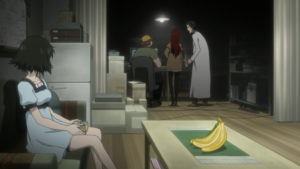 And that brings us to pacing. Steins;Gate is somewhat known for its slow start, and for good reason. For the first three or four episodes, you’re kinda left wondering if this time travel thing the show seems to be built around is even real. And, if it is real, will it ever be consequential enough to carry a twenty four episode series? The constant setbacks and limited time travel successes Okabe and friends achieve with their strange cellphone activated microwave almost leads you to believe that Steins;Gate is going to be about the boring, unimportant subtleties of time travel. But that’s not the case at all!
And that brings us to pacing. Steins;Gate is somewhat known for its slow start, and for good reason. For the first three or four episodes, you’re kinda left wondering if this time travel thing the show seems to be built around is even real. And, if it is real, will it ever be consequential enough to carry a twenty four episode series? The constant setbacks and limited time travel successes Okabe and friends achieve with their strange cellphone activated microwave almost leads you to believe that Steins;Gate is going to be about the boring, unimportant subtleties of time travel. But that’s not the case at all!
Every episode in the first half of Steins;Gate is packed with good character moments and interesting plot developments, even when those developments are occasional subtle. As an example, Okabe and friends at one point early on try to prove they can send messages back in time by attempting to win the previous day’s lottery. It’s a classic time travel trope. And their plan works… except the person they send the winning lottery numbers to gets them mixed up and they don’t end up winning after all. That’s the sort of thing that keeps occurring in the first half of Steins;Gate. Except it’s not the whole story.
 The closer Steins;Gate gets to it’s half way point, the more show ratchets up it’s level of tension. Things that seem innocent or incidental at first keep becoming more and more important and keep intruding more and more on the somewhat leisurely flow of the plot. Little by little, the story starts to accelerate, and you do start to see major consequences caused by Okabe’s meddling in time travel. By the time you reach the halfway point you know something big is going to happen. And then it does. And from then on the show’s pace changes from lazily drifting down a stream to battling the toughest white water river rapids imaginable. You quickly come to realize that the first half of the show was like the long slow pull up the first big hill of a roller coaster. Once you get to the top, the show doesn’t stop and doesn’t let up until it puts you through a series of thrilling high speed loops and drops and turns that continue all the way to the end.
The closer Steins;Gate gets to it’s half way point, the more show ratchets up it’s level of tension. Things that seem innocent or incidental at first keep becoming more and more important and keep intruding more and more on the somewhat leisurely flow of the plot. Little by little, the story starts to accelerate, and you do start to see major consequences caused by Okabe’s meddling in time travel. By the time you reach the halfway point you know something big is going to happen. And then it does. And from then on the show’s pace changes from lazily drifting down a stream to battling the toughest white water river rapids imaginable. You quickly come to realize that the first half of the show was like the long slow pull up the first big hill of a roller coaster. Once you get to the top, the show doesn’t stop and doesn’t let up until it puts you through a series of thrilling high speed loops and drops and turns that continue all the way to the end.
If it’s solid, exciting time travel plot is one of Steins;Gate’s strengths, its characters are its other strong point.
Okabe plays the role of pretend mad scientist with equal parts charm and delusion. He’s really not so out of the ordinary when he occasionally drops out of his crazier persona, but when he is fully in his role as mad scientist Hououin Kyouma, he can be quite egotistical and infuriating to his friends.
Daru plays a great straight man to Okabe’s mad scientist, but he can be just as wacky as Okabe thanks to his occasional semi-lewd observations and his devotion to his online video game character harem that he has to keep up with.
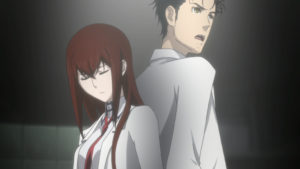 Then there’s Makise who really is the show’s second main character. She is intelligent and witty and is constantly verbally sparing with the goofier Okabe over everything from legitimate scientific theory to how bad she is at cooking. One of the funnest things about Makise is she’s just as much of a nerd as Okabe and Daru are, but unlike them, she does her best to keep that fact hidden. Her attempts to hide her knowledge of nerd culture lead to some of the best lines of dialogue in the series, and Okabe’s teasing, antagonistic love/hate relationship with her is a highlight of the show.
Then there’s Makise who really is the show’s second main character. She is intelligent and witty and is constantly verbally sparing with the goofier Okabe over everything from legitimate scientific theory to how bad she is at cooking. One of the funnest things about Makise is she’s just as much of a nerd as Okabe and Daru are, but unlike them, she does her best to keep that fact hidden. Her attempts to hide her knowledge of nerd culture lead to some of the best lines of dialogue in the series, and Okabe’s teasing, antagonistic love/hate relationship with her is a highlight of the show.
Steins;Gate also has a small cast of interesting characters who help or hinder Okabe in various ways. The stories of these seemingly minor characters are a lot more personal and fleshed out than you might expect, and actually play a larger role in the main story than you might at first think. There are some great, weighty moments that I don’t want to spoil, but check out the Dig Deeper section below if you are interested in learning more about these side stories and why they are included alongside the main plot.
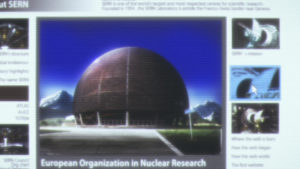 One final thing that makes Steins;Gate’s story so good is that it pulls in a lot of real world elements and twists them around for its own fictional purposes. For instance, time traveler John Titor actual was the originator of the time travel theories that the lecturer plagiarized at the beginning of the first episode. “John Titor” was a real username who posted on message boards about time travel back in 2001. Likewise SERN, a misspelling of the real world CERN, better known as the European Organization for Nuclear Research is a real world group of scientists who do high energy particle physics. Their fictional counterparts play a major role in Steins;Gate and help make the show feel more grounded in reality than it otherwise would.
One final thing that makes Steins;Gate’s story so good is that it pulls in a lot of real world elements and twists them around for its own fictional purposes. For instance, time traveler John Titor actual was the originator of the time travel theories that the lecturer plagiarized at the beginning of the first episode. “John Titor” was a real username who posted on message boards about time travel back in 2001. Likewise SERN, a misspelling of the real world CERN, better known as the European Organization for Nuclear Research is a real world group of scientists who do high energy particle physics. Their fictional counterparts play a major role in Steins;Gate and help make the show feel more grounded in reality than it otherwise would.
Graphics & Sound
 Graphically, Steins;Gate is… different. It has plenty of detail in its characters and backgrounds, and while it’s by no means an animation powerhouse, it gets by well enough. What makes it a little odd is its palette and style that sorta sucks the color out of most of its scenes. Indoors, this mostly just means that a lot of the colors, especially the background colors, are somewhat muted. But outdoors, the show often combines its subdued colors with bright glare meant to convey the heat of summer. This subdued but also blown-out look was a little distracting to me at first and took a while to get used to. I wouldn’t even say its unique style is used to any great effect. It simply is what it is and you can like it or not. Personally, I kinda don’t.
Graphically, Steins;Gate is… different. It has plenty of detail in its characters and backgrounds, and while it’s by no means an animation powerhouse, it gets by well enough. What makes it a little odd is its palette and style that sorta sucks the color out of most of its scenes. Indoors, this mostly just means that a lot of the colors, especially the background colors, are somewhat muted. But outdoors, the show often combines its subdued colors with bright glare meant to convey the heat of summer. This subdued but also blown-out look was a little distracting to me at first and took a while to get used to. I wouldn’t even say its unique style is used to any great effect. It simply is what it is and you can like it or not. Personally, I kinda don’t.
Where Steins;Gate shines, however, is in its dialogue and voice acting. It’s fine in Japanese, and there’s some great moments like Okabe’s odd broken English greeting to a back alley vendor, but I will probably never watch it in Japanese again because the show is stellar in English. Steins;Gate is one of maybe five anime that I’ll hold up as incontrovertibly better in English than they are in Japanese. In either language, Steins;Gate’s dialogue is fast paced and witty, but in English, Funimation both provided great voice actors and made some substantial changes to the dialogue to make it flow better for an English audience.
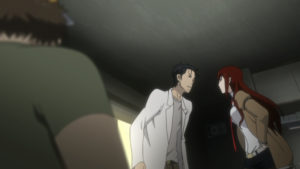 What this means is, the English dialogue and acting in Steins;Gate is among the best of the best. Conversations flow brilliantly and you can hear every emotion the characters are conveying. But it also means that English dub is very decidedly not a direct translation. If that matters to you, by all means stick to the Japanese. In most places, this is wonderful. In episode 9, for instance, the English dub swaps out a confusing joke about @channel (Steins;Gate’s in-universe version of Twitter) for a trio of sly references to Star Trek. This kind of thing happens throughout the series. The English dub never changes the intent of the characters and it doesn’t at all alter the plot, but individual words, sentences, and exchanges can and do sometimes end up a bit different in the English version than they were in Japanese.
What this means is, the English dialogue and acting in Steins;Gate is among the best of the best. Conversations flow brilliantly and you can hear every emotion the characters are conveying. But it also means that English dub is very decidedly not a direct translation. If that matters to you, by all means stick to the Japanese. In most places, this is wonderful. In episode 9, for instance, the English dub swaps out a confusing joke about @channel (Steins;Gate’s in-universe version of Twitter) for a trio of sly references to Star Trek. This kind of thing happens throughout the series. The English dub never changes the intent of the characters and it doesn’t at all alter the plot, but individual words, sentences, and exchanges can and do sometimes end up a bit different in the English version than they were in Japanese.
There’s not a lot to talk about in terms of music for Steins;Gate. There is some music, I guess, during tense or important scenes, but I can hardly recall it. What did stand out to me, though, was its opening theme. “Hacking to the Gate” is upbeat and relevant to the plot without being any kind of direct spoiler. I still listen to it on occasion, but this is not a show where I picked up the full instrumental score like I do for some of my other favorites.
All In All:
Steins;Gate is one of my favorite anime of all time. Its combination of great characters, fantastic witty dialogue, and a very strong time travel plot kinda checked all the boxes for me. Yes, it’s a little slow in the beginning, but rest assured that things really do build on themselves and pick up as the show approaches the half-way mark. Steins;Gate has tension, and emotion, and excitement to spare, it simply doesn’t show its full hand nearly as quickly as some other shows. But once it does hit its proverbial 88 miles per hour, you will, indeed, see some serious shit! (What?! I had to get a Back to the Future reference in there somewhere!)
Steins;Gate’s Visual Novel Influences:
One of the interesting points that I kinda feel is necessary to fully understanding Steins;Gate – the anime – is that it was based upon Steins;Gate – the visual novel. For those that don’t know, Visual Novels are a popular type of role playing game in Japan. In them, you typically play a lead character in a story and you travel around various locations in an area such as a town and have branching conversations with several other characters. But it’s almost all presented in fixed screens and backgrounds and unmoving character art instead of in 3d like an open world game. Visual Novels often have several different endings depending on who you talk to and what what you say to them and what dramatic choices you make.
Steins;Gate is one of the better known Visual Novels, but there are other anime based on Visual Novels you might recognize. For instance, Fate/stay night was also originally a Visual Novel. In the Steins;Gate game, you played as Okabe and, along with talking to the characters represented in the anime, you could also receive text messages from the future where acting on them was critical to get one of the better endings. To get the best ending, which is basically the one depicted in the anime, you almost had to replay the game multiple times so you could act on information you learned during your previous failures.
Steins;Gate’s original form being a Visual Novel also plays into some of the anime’s plot choices. The various one off episodes where Okabe spends time with each of the girls and rolls back their altered futures comes directly from the Visual Novel. Depending on your choices Okabe could end up paired off with any one of the girls in one of the game’s multiple good endings. Or he could end up dead in various ways in the game’s multiple bad endings. The anime pays respect to that by working in most of those sub stories that were mutually exclusive from each other. You actually had to play the game several times to see each of the endings.
In the anime, I thought this worked fine, but it does shed a little light on why the anime seemed to string a few side stories together and made them critical to progressing the main story of saving Mayuri and Makise.
The Almost Perfect Time Travel Plot:
Out of all the time travel shows and movies I’ve seen, I think Steins;Gate has one of the best, most consistent time travel plots out there. All the pieces fit into place across several timelines and several failed attempts to set things right… except one thing. I’ve never been able to justify the video Okabe gets from himself being static the first time he looks at it. Oh, the justification in the show is fun and clever… that it was locked or inaccessible until he moved onto the worldine where he killed Makise, or some such thing. But how does that make any sense? I think it would have been better if he’d never looked at the video of if it had been slow to download so he didn’t have time to look at it before he had to rush to see Makise seemingly dead in the hallway. The way it is now, it feels like the one puzzle piece that doesn’t fit into the great time travel plot.